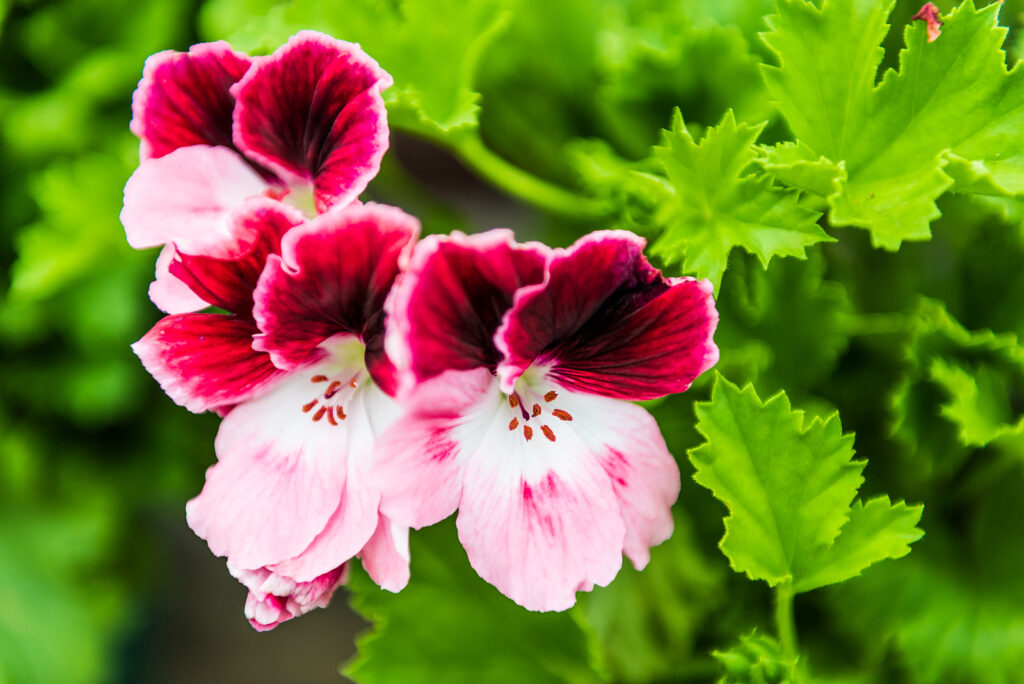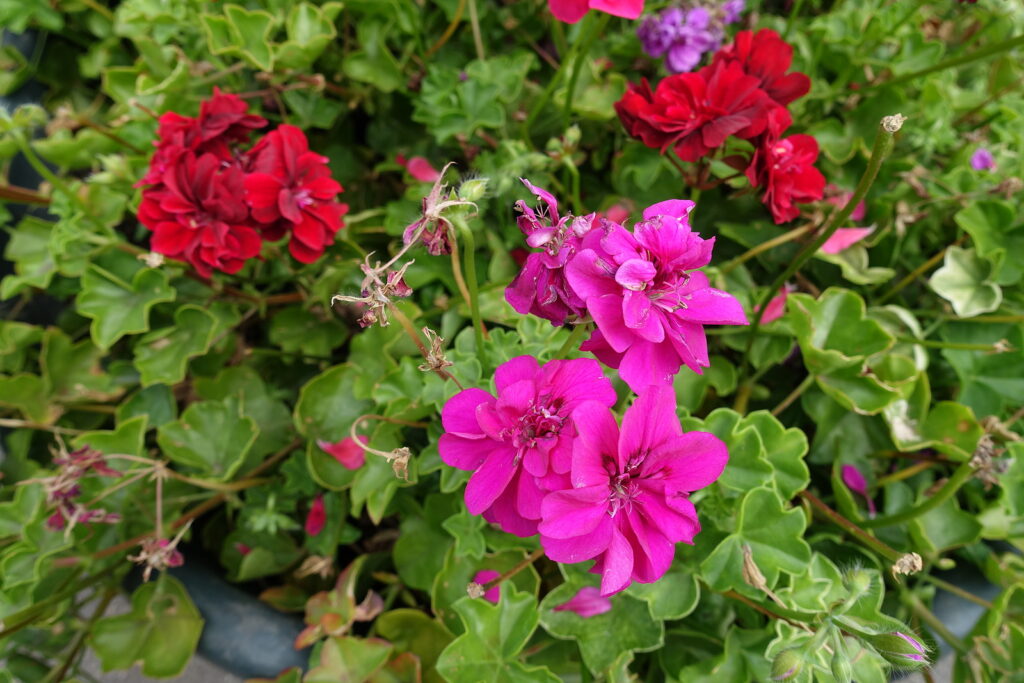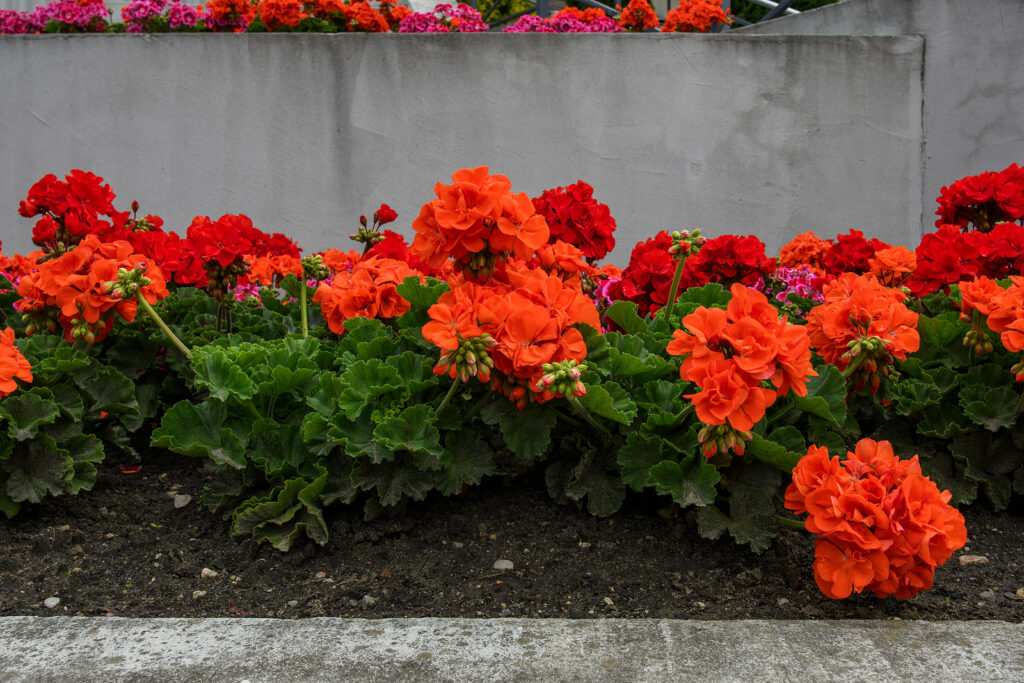How to Grow Geranium — Pelargonium
Pelargonium is a genus of tender perennials that includes the popular garden plant widely known as geranium. The best-known Pelargoniums go by the common names zonal geraniums, ivy-leaved geraniums, and regal or Martha Washington geraniums. Pelargoniums also include scented-leaved geraniums.
Pelargoniums are often grown as annuals. They are native to South Africa and cannot tolerate frost. Pelargoniums often continue to flower when brought indoors for the winter.
There are about 230 species of mainly evergreen Pelargoniums. Most cultivars are derived from about 20 species. Pelargoniums, at least in name, are sometimes confused with hardy, long-lived geraniums, members of a separate genus called Geranium. Hardy geraniums are commonly called cranesbill and are sometimes dubbed “true geraniums” to distinguish them from Pelargoniums.
Pelargoniums bear five-petaled, star- or saucer-shaped flowers that are carried in rounded clusters that resemble umbels. Most Pelargoniums bloom from spring to frost; in frost-free regions, many bloom year-round. Pelargoniums have rounded or deeply cut or fernlike leaves that are hairy and sometimes aromatic.
Pelargonium is a genus of about 280 species of mostly evergreen perennials, succulents, sub-shrubs, and shrubs, commonly known as geraniums. Most cultivars grown as garden plants are derived from about 20 species.

Pelargonium Overview
Pelargonium, often mistaken for geraniums, is a genus of flowering plants native to South Africa. Known for their vibrant flowers, aromatic foliage, and drought tolerance, Pelargoniums are a favorite in gardens worldwide. They come in several types, including:
- Zonal Pelargoniums (Pelargonium x hortorum): Classic bedding plants with rounded, scalloped leaves often marked with a darker “zone.”
- Ivy-Leaf Pelargoniums (Pelargonium peltatum): Trailing plants with glossy, ivy-shaped leaves, perfect for hanging baskets.
- Scented-Leaf Pelargoniums: Grown primarily for their fragrant foliage, which can smell like rose, lemon, mint, or spice.
- Regal Pelargoniums (Pelargonium domesticum): Featuring large, showy flowers often with frilled edges.
- Unique Pelargoniums: Rare varieties prized for their unusual foliage and flower forms.
Using Pelargonium in the Garden
- Borders and Bedding: Zonal Pelargoniums are perfect for adding bold color to borders and bedding schemes. Their continuous blooms create a bright, structured look that complements annuals and perennials.
- Container Gardening: Use Ivy-Leaf Pelargoniums in hanging baskets or window boxes, where their trailing growth habit creates a cascading effect. Combine Zonal or Regal Pelargoniums with other sun-loving plants in containers for vibrant patio displays.
- Fragrance Gardens: Scented-Leaf Pelargoniums are excellent additions to sensory or herb gardens. Their foliage releases fragrance when brushed or touched, making them ideal for pathways or patio edges.
- Companion Planting: Place Pelargoniums near vegetables or other plants to repel pests like aphids and whiteflies. The strong scent of some varieties may deter deer or rabbits.
- Drought-Tolerant Landscapes: Pelargoniums thrive in dry conditions and are a great choice for xeriscaping or rock gardens. Pair them with succulents or other drought-tolerant species for a low-maintenance garden.
- Cut Flowers and Indoor Displays: The vibrant blooms of many Pelargoniums work well as cut flowers. Potted varieties can also be brought indoors as temporary houseplants during the growing season.
Pelargoniums Quick Care Tips
- Light: Full sun is essential for abundant blooms, though they tolerate partial shade.
- Soil: Well-draining soil with moderate fertility works best. Avoid overly rich soils to prevent leggy growth.
- Watering: Water deeply but infrequently, allowing the soil to dry between waterings. Overwatering can cause root rot.
- Pruning: Deadhead spent flowers and remove yellowing leaves to encourage continuous blooming.
- Winter Care: In frost-prone areas, bring Pelargoniums indoors before the first frost or treat them as annuals.
Pelargoniums bring beauty, fragrance, and versatility to gardens, making them a must-have for gardeners of all experience levels! Do you have a specific type or use in mind?Get to know Pelargonium
Get to Know Pelargoniums
- Plant type: Annual, perennial in mild climates
- Growing Zones and range: 8-11; grow as annuals in Zones 2-9; grow as perennial in Zones 10-11
- Hardiness: Tender, cannot tolerate frost
- Height and width: 8 to 24 inches (20-61cm) tall and wide; can grow into a large shrub outdoors in frost-free regions.
- Foliage: Leaves can be scalloped, heart-shaped, oval, or rounded, furry or smooth, and scented or unscented.
- Flowers: Flowers are saucer- or star-shaped, trumpet- or funnel-shaped; the upper two petals are larger than the lower three; flower clusters are flat-topped
- Flower colors: Red, white, pink, salmon, or lavender, sometimes bicolored
- Bloom time: Spring through frosts, all year in mild climates
- Uses: Beds, containers, hanging baskets, window boxes, sometimes grown as a houseplant
- Common name: Geranium, bedding geranium
- Botanical name: Pelargonium spp.
- Family: Geraniaceae
- Origin: From mountains to deserts, mostly in South Africa
Where to plant Pelargonium
- Plant pelargoniums in full sun in Zones 2-8; plant in light shade in Zones 9-11.
- Grow pelargoniums in humus-rich, well-drained soil.
- Pelargoniums prefer a soil pH of 6 to 7.
Pelargonium uses
- Where not winter hardy, use Pelargoniums in containers outside in summer or as bedding plants
- In frost-free regions, grow Pelargoniums in a sunny border. Pelargoniums mix well with sweet alyssum and petunias.
- Upright and bushy types can be planted in window boxes.
- Trailing ivy types are ideal for cascading from hanging baskets.

When to plant Pelargonium
- Set pelargoniums in the garden in spring after all danger of frost has passed.
- Start seed indoors 6 to 8 weeks before the last spring frost.
- Start plants from cuttings indoors in early spring.
Planting and spacing Pelargonium
- Start seed in flats or small pots; use a sterile potting mix. Sow seed 1/8 inch deep. Keep seed warm at about 70°F (21°C) until seeds germinate; then move seedlings to a sunny window or under fluorescent light.
- Transplant seedlings to larger pots when they have at least two true leaves.
- Plant 3 to 4-inch (7.6-10cm) cuttings indoors; plant the cuttings 1 inch (2.5cm) deep in a sterile potting mix. Roots will develop in 3 to 4 weeks.
- Space pelargoniums in the garden 18 to 24 inches (45-61cm) apart.

How to water and feed Pelargonium
- Pelargoniums need moderate water; keep the soil evenly moist but not wet otherwise stems may rot. Avoid heavy soakings.
- Allow the soil around potted pelargoniums to dry at the surface between waterings. Ivy geraniums are drought tolerant.
- Fertilize pelargoniums with an all-purpose fertilizer every 4 to 6 weeks during the growing season. Increase the strength of the fertilizer if the leaves become yellow.
- Do not fertilize pelargoniums for a two-month period in winter; allow the plants to rest.
Pelargonium care
- Mulch around pelargoniums to conserve soil moisture.
- Remove spent blooms to encourage new blooms.
- Overwinter pelargoniums by potting them up and moving them indoors before the first frost in fall; keep them in a sunny room.
Growing Pelargoniums as a houseplant
- Pelargonium graveolens and P. tomentosum are often grown as houseplants.
- Give Pelargoniums direct light, average room temperature, and medium humidity.
- Pelargoniums will grow well under fluorescent lights, especially in winter.
- Plant in a soilless medium; the soil should be allowed to dry between thorough waterings, overwatering can result in mildew and rot.
- In winter, water sparingly, just enough to keep the plant from wilting.
- Fertilizer can be applied every two weeks during spring and summer.
- Remove flowers as they fade.
- Pinch out growing tips to encourage branching and compact growth.

Pelargonium pests and diseases
- Pelargoniums can be attacked by verticillium wilt, a soil-borne fungus, that results in weak yellow leaves and lack of vigor; if this disease is persistent, grow pelargoniums in containers.
- Pelargoniums can be attacked by leaf-eating caterpillars; spray plants with Bacillus thuringiensis insecticide.
Pelargonium propagation
- Pelargoniums can be propagated by seed or cuttings. Sow seed in spring, see above.
- Seeds germinate in 7 to 10 days at 70° to 75°F (21°-24°C). From seed, plants need 13 to 15 weeks to come into bloom.
- Take cuttings from overwintered plants in early spring—plant 3 to 4-inch (7.6-10cm) cuttings 1 inch deep in sterile potting mix. Keep cuttings at about 70°F (21°C) until they root in about 3 to 4 weeks.
- Harden off new plants before setting them outdoors.

Pelargonium varieties to grow
- Pelargonium domesticum (called Martha Washington or Regal geranium) bears rounded, sometimes lobed leaves on 1 to 4-foot plants; single or sometimes double flowers carried in 2- to 4-inch clusters in solid colors of red, purple, pink, white, maroon, and orange.
- P. graveolens, rose geranium. Grows erect to 30 inches tall; leaves are gray-green deeply cleft, hairy, and 2 to 3 inches long; sweet-scented rose fragrance.
- P. x hortorum (commonly called a zonal geranium, bedding, or common geranium) bears showy 3- to 5-inch wide clusters of 1-inch-wide flowers from early summer to frost. Single-flowered types bear five petals per flower are the most common; varieties include ‘Big Red’, ‘Freckles’, and ‘Neon Rose’. “Rosebud” type common geraniums bear double-flowers. Leaves are marked by a dark ring or “zone.”
- P. peltatum (ivy geranium) has fleshy, lobed, ivylike leaves and trailing stems from 3 to 4 feet long; bear clusters of single or double flowers in shades of pink, mauve, lilac, and white. Ideal for hanging baskets or window boxes. Ivy geraniums are drought tolerant.
- P. tomentosum, peppermint geranium. Grows erect when young then trails; leaves are bright green, heart-shaped, velvety, and 3 inches long; has strong peppermint fragrance when touched; clusters of white or pale pink flowers.
- Scented geraniums are a mix of species and cultivars. Cultivars include apple, lemon, and peppermint-scented leaves. Small, single flowers are in shades of red, mauve, pink, purple, or white. Scented geranium species include Pelargonium crispum (lemon-scented geranium), P. graveolens (rose scented), P. odoratissimum (nutmeg scented), P. tomentosum (peppermint scented).
Geranium Pelargonium frequently asked question
Q: What kind of soil should geraniums have to get good flowers?
A: A half-and-half mixture of good garden loam and sand or Perlite will grow good flowering geraniums. Apply a liquid fertilizer when plants are growing, not when they are resting.
Q: What is the best fertilizer for geraniums?
A: A low-nitrogen fertilizer is best. Nitrogen is the first number in the fertilizer formulas. It encourages leafy growth rather than blooms.
Q: When is it safe to plant geraniums in the open garden?
A: After all danger of frost has passed and the ground has warmed up. Harden plants gradually before planting by standing them for a few days under an awning, on the porch, or in a cold frame.
Q: Should I break the soil and spread out the roots of potted geraniums when I plant them in the garden?
A: No, leave the root ball intact. Geraniums do like their roots being disturbed. Soak the rootball for an hour before planting. Make a hole plenty big enough, press the soil firmly about the ball, and water well. the top of the ball should be a half inch below the surface.
Q: What window is best if I grow geraniums in the house?
A: Place geraniums in the sunniest window. They like it cool, somewhat below 68°F during the day and about 10 degrees cooler at night. Turn the plant frequently so that all parts get the light and growth is shapely.
Q: What is the best size pot for a potted geranium?
A: Pots should be adjusted to the size of the plant. Avoid pots too large for the plant. When a pot is filled with healthy roots, transfer to a pot size one or two larger. Use well-drained soil.
Q: How should I water a potted geranium?
A: Watering must be adjusted for the individual plant and environment. Aim to keep the soil moist but not bog-like wet. When water is given, saturate the whole ball of soil. Let the soil approach dryness between waterings. Sunshine, high temperature, breezy weather, and vigorous growth all make more frequent watering necessary.
Q: How do I correct the growth habit of a spindly and lop-sided geranium?
A: You may “stop” the plant growing by pinching out the tips of the growing shoots. If necessary, prune the stems back to force new growth nearer the base of the plant.
Q: Why do the leaves of blooming geraniums turn brown and drop off?
A: Many possible causes: too dry atmosphere; lack of water; too much water; damage to roots when transplanting or repotting; or too strong fertilizer or spray.
Q: What causes geranium leaves to turn pale green and not thrive?
A: Probably the plants are getting too little light. Low temperatures could also be a factor. Try full sunshine and a minimum temperature of 55°F.
Q: What causes the buds of geranium to turn brown and dry up?
A: Low humidity is the most likely cause of trouble. Place potted plants in a tray of pebbles with water to the top of the pebbles.
Q: What is a good method for propagating geraniums?
A: By cuttings–terminal pieces of stem 4 or 5 inches long with lower leaves removed and bases cut cleanly across just beneath a joint. Plant firmly in clean sand; keep shaded from direct sunshine and in a fairly moist atmosphere at about 60°F. The most favorable times to root cutting are mid-spring and late summer.
Q: How long after the geranium seed is planted may blooms be expected?
A: Blooms should come in 4 to 6 months.







